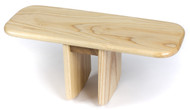A Guide to Using a Meditation Bench
Posted by Jay Suthers on Apr 30th, 2024
Finding Your Perfect Posture: A Guide to Using a Meditation Bench
Meditation is a practice that can benefit everyone, but finding a comfortable position can be a challenge. Enter the meditation bench, a simple yet effective tool designed to enhance your posture and deepen your meditation experience.
Why Use a Meditation Bench?
Traditional meditation postures involve sitting on the floor, which can be uncomfortable for some people, especially those with back problems or tight hamstrings. A meditation bench offers several advantages:
- Improved Posture: The elevated seat of a bench helps you maintain a naturally upright posture, reducing strain on your back and neck.
- Reduced Knee Pressure: Unlike kneeling meditation postures, a bench takes pressure off your knees and ankles, making it more comfortable for longer sessions.
- Promotes Alertness: Sitting slightly elevated can keep you more alert and prevent drowsiness during meditation.
Choosing the Right Bench:
Meditation benches come in various styles and heights. Here are some factors to consider when choosing one:
- Height: Ideally, your knees should bend at a comfortable angle (about 45-degrees) when you sit on the bench with the top of your feet flat on the floor.
- Material: Meditation benches are typically made of wood or bamboo, but cushioned options are available for added comfort.
- Inclination: Some benches have a slight backward tilt, which can further promote proper posture.
Using Your Meditation Bench:
Here's a basic guide on how to use your meditation bench:
- Placement: Position your bench on a firm, flat surface in a quiet and distraction-free environment. You may want to place it on a meditation cushion (zabuton) for added comfort.
- Sitting Position: Sit comfortably on the bench with your legs under the bench and the top of your feet flat on the floor.
- Posture: Maintain a tall spine with your shoulders relaxed and rolled back. Your chin should be slightly tucked in, and your gaze can be gently softened downwards.
- Breathing: Focus on your breath, feeling your belly rise and fall with each inhale and exhale.
Tips for Comfort:
- Adjust Your Ankles: If the top of your feet will not lay flat, you can roll up a towel or blanket and place it under your ankles for support. Small pillows may also be used.
- Back Support: Many benches come with a fixed angled top or with rounded feet so that the angle of the bench can be adjusted. This will tilt the pelvis forward causing the lower spine to turn inward creating a supportive "S" shape in the spine.
- Meditation Clothes: Wear loose and comfortable clothing that won't restrict your movement during meditation.
Remember:
The goal of using a meditation bench is to find a comfortable posture that allows you to remain alert and focused throughout your practice. Don't be afraid to experiment and find what works best for you. With consistent practice and the right tools, meditation can become a source of peace and relaxation in your life.
Shop for Meditation Cushions Here.
I hope this is helpful but please let me know if you have any questions or thoughts.
Sincerely Yours,
Jay
If you would like to comment on this blog or have any questions, please feel free to Contact Sage Meditation Customer Service.

